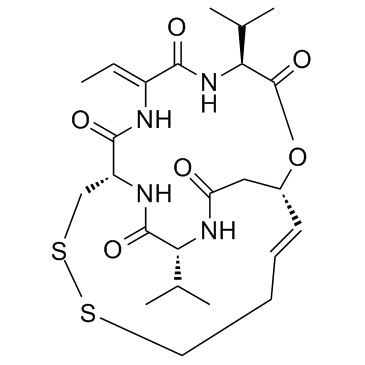
Romidepsin
CAS No. 128517-07-7
Romidepsin ( FK228, Depsipeptide )
Catalog No. M11164 CAS No. 128517-07-7
Romidepsin (FK228, depsipeptide) is a potent HDAC1 and HDAC2 inhibitor with IC50 of 36 nM and 47 nM, respectively.
Purity : >98% (HPLC)
 COA
COA
 Datasheet
Datasheet
 HNMR
HNMR
 HPLC
HPLC
 MSDS
MSDS
 Handing Instructions
Handing Instructions
| Size | Price / USD | Stock | Quantity |
| 2MG | 139 | In Stock |


|
| 5MG | 224 | In Stock |


|
| 10MG | 404 | In Stock |


|
| 25MG | 583 | In Stock |


|
| 50MG | 830 | In Stock |


|
| 100MG | 1125 | In Stock |


|
| 200MG | Get Quote | In Stock |


|
| 500MG | Get Quote | In Stock |


|
| 1G | Get Quote | In Stock |


|
Biological Information
-
Product NameRomidepsin
-
NoteResearch use only, not for human use.
-
Brief DescriptionRomidepsin (FK228, depsipeptide) is a potent HDAC1 and HDAC2 inhibitor with IC50 of 36 nM and 47 nM, respectively.
-
DescriptionRomidepsin (FK228, depsipeptide) is a potent HDAC1 and HDAC2 inhibitor with IC50 of 36 nM and 47 nM, respectively.(In Vitro):Romidepsin (0-72 hours; 0-80 nM) inhibits proliferation of HCC cells in dose-dependent manner.Romidepsin (0-48 hours; 0-60 nM) leads to a time- and dose-dependent induction of cell cycle arrest in the G2/M phase in HCC cells.Romidepsin (0-48 hours; 0-60 nM) promotesapoptosis in HCC cells, increases c-caspase-3, c-caspase-9, and c-PARP protein expression.(In Vivo):Romidepsin (intraperitoneal injection; 0.5 and 1 mg/kg; every 3 day; 21 days) inhibited the tumor growth, reveals a higher expression of p-cdc25C, ki67, c-caspase-3 and c-PARP, and a lower expression of Ki-67 in Romidepsin treated tumors .
-
In VitroCell Proliferation Assay Cell Line:HCC cells Concentration:0 nM; 10 nM; 20 nM; 30 nM; 40 nM; 50 nM; 60 nM; 70 nM; 80 nM Incubation Time:0 hours; 12 hours; 24 hours; 48 hours; 72 hours Result:Inhibited HCC cells proliferation.Cell Cycle Analysis Cell Line:HCC cells Concentration:0 nM;15 nM; 30 nM; 60 nM Incubation Time:12 hours;24 hours; 48 hours Result:Caused a G2/M arrest.Western Blot Analysis Cell Line:HCC cells Concentration:0 nM;15 nM; 30 nM; 60 nM Incubation Time:12 hours;24 hours; 48 hours Result:Increaesd c-caspase-3, c-caspase-9, and c-PARP expression in HCC cells.
-
In VivoAnimal Model:Nude mice with Huh7 cells Dosage:0.5 and 1 mg/kg Administration:Intraperitoneal injection; 0.5 and 1 mg/kg; every 3 day; 21 days Result:Suppressed tumor growth in mouse xenograft models.
-
SynonymsFK228, Depsipeptide
-
PathwayCell Cycle/DNA Damage
-
TargetHDAC
-
RecptorHDAC1| HDAC2
-
Research AreaCancer
-
Indication——
Chemical Information
-
CAS Number128517-07-7
-
Formula Weight540.7
-
Molecular FormulaC24H36N4O6S2
-
Purity>98% (HPLC)
-
SolubilityDMSO: 10 mg/mL (18.49 mM)
-
SMILESO=C([C@H](C(C)C)NC(/C(N1)=C/C)=O)O[C@](CC(N[C@H](C(C)C)C(N2)=O)=O)([H])/C=C/CCSSC[C@]2([H])C1=O
-
Chemical Name(1S,4S,7Z,10S,16E,21R)-7-ethylidene-4,21-bis(1methylethyl)-2-oxa-12,13-dithia-5,8,20,23-tetraazabicyclo[8.7.6]tricos-16ene-3,6,9,19,22-pentone
Shipping & Storage Information
-
Storage(-20℃)
-
ShippingWith Ice Pack
-
Stability≥ 2 years
Reference
1.Furumai R, et al. Y Res, 2002, 62(17), 4916-492
molnova catalog



related products
-
MPT0G211
MPT0G211 is a novel potent, selective HDAC6 inhibitor with IC50 of 0.291 nM.
-
SB-379278A
A potent and selective HDAC8 inhibitor with IC50 of 0.5 uM.
-
SBHA
SBHA (suberohydroxamic acid) is a Histone deacetylase (HDAC) inhibitor. HDAC is required for transcriptional modulation, cell cycle regulation and development.



 Cart
Cart
 sales@molnova.com
sales@molnova.com


